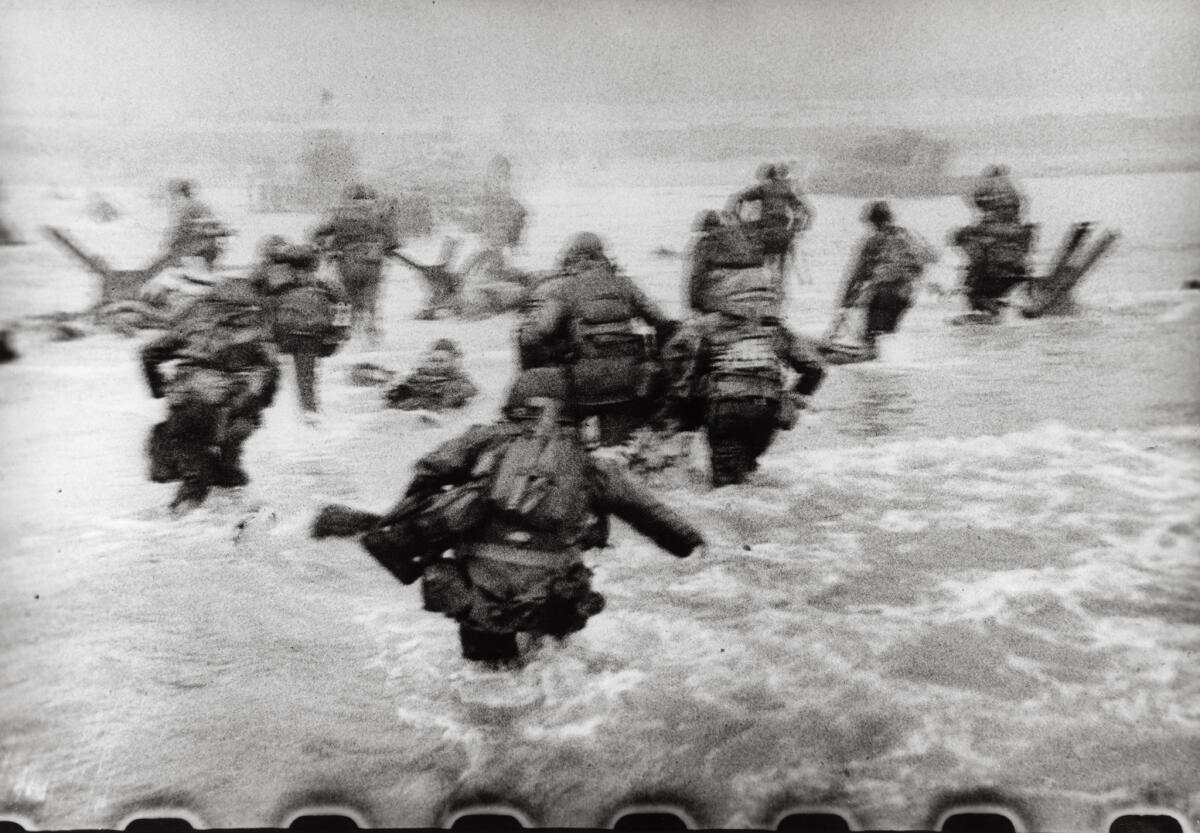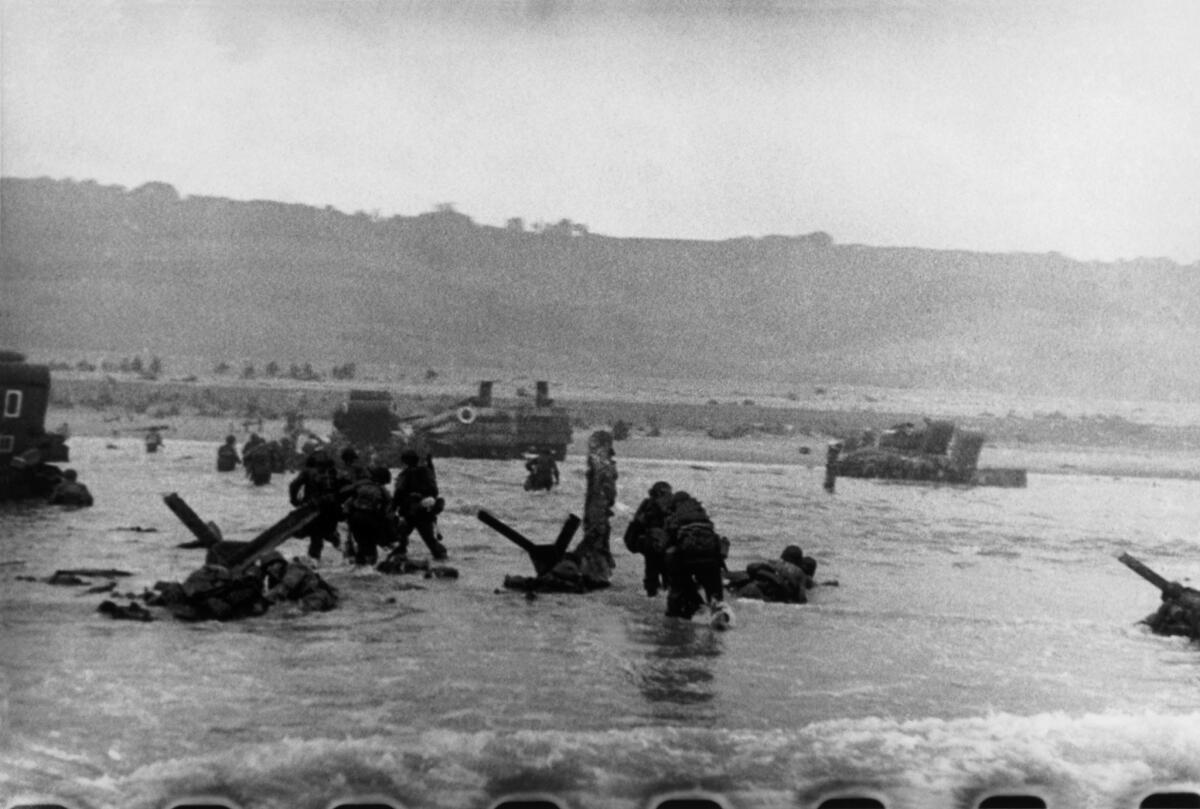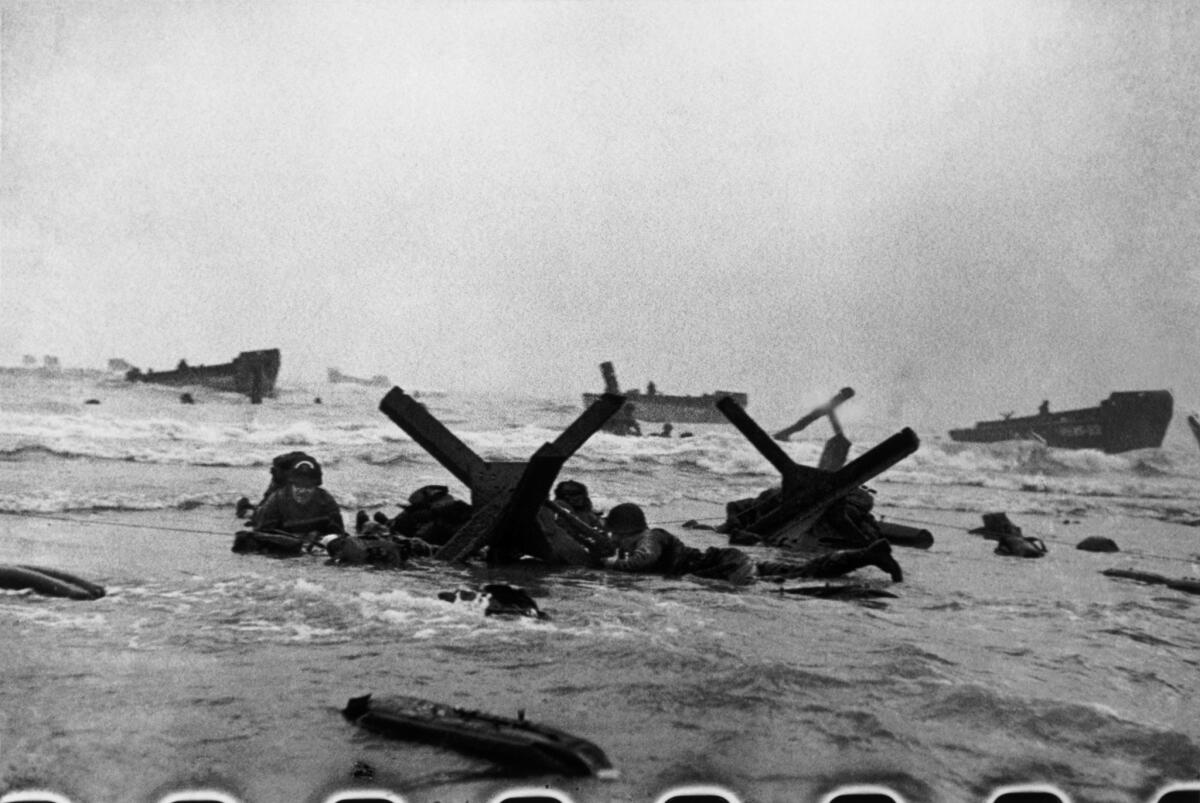Op-Ed: The D-day photos that must be seen
- Share via
Some photos must be taken, some images must be seen. These thoughts must have motivated photographer Robert Capa 75 years ago as he plunged off a landing craft and onto Omaha Beach with an early wave of the D-day landings.
“If your pictures aren’t good enough,” Capa famously advised, then “you’re not close enough.”
He was close enough on June 6, 1944, to secure what are now known as the Magnificent Eleven, the surviving images on four rolls of film delivered from Normandy to London just a day and a half after the Allied assault on Europe began. Five of the photos — “slightly out of focus,” in Capa’s words — were published in the next issue of Life magazine, dated June 19, 1944: Battle scenes in blurred black and white; frenzied, grim.


The stark face of a helmeted soldier caught in swirling water, often cited as the iconic image of the “longest day,” captured the landing’s essential danger: drown or fight. Capa’s D-day shots reportedly inspired director Steven Spielberg’s wrenching, realistic take on the landings in “Saving Private Ryan.” To pierce Hitler’s Atlantic Wall, more than 16,000 Americans would die and 40,000 would be wounded by the end of July.
Great photos matter. They do two things, simultaneously: zoom us in on some frozen moment, and then widen our apertures to the world in a way that transcends words alone.
Often the pictures that hit us hardest depict violence. Of the 133 winners of the Pulitzer Prizes for photography, more than half — 69 — have been connected in some way to man-made conflict. Given a choice, the prize-givers honor such images because, as graphic and grisly as they may be, they are crucial to public understanding in a dangerous world.
During the Vietnam War, Eddie Adams’ image of a Saigon street-side execution during the Tet Offensive and Nick Ut’s of a naked child fleeing a napalm attack were as powerful as they were brutal. In 1991, Greg Marinovich captured the mayhem during the fall of apartheid in South Africa. He had pleaded with vigilante killers to stop, but when they didn’t, he kept shooting, and the photograph of a machete splitting a victim’s flaming skull told the story to the world.
Seeing is still believing, as long as the image is authentic, which is another way of underlining Capa’s commandment to get “close enough.” Horst Faas, himself the winner of two Pulitzer Prizes, once described crawling to the “forward trenches of a besieged outpost” and waiting “beside riflemen in night ambushes” to get a good shot during the Vietnam War. “We worked hard to be truthful,” he wrote in a collection of Pulitzer images, and purposely “avoided pictures of the bizarre and the atypical.”
A photo might very well be real, it might be representative, but the final question is often the toughest: Is it relevant?
“If it makes you laugh, if it makes you cry, if it rips out your heart, that’s a good picture,” said Adams.
Americans a world away from the battle are obliged to stop and stare at such pictures; never more so than in the 21st century. The post-9/11 war costs so far are tallied at just under $6 trillion, with about 7,000 U.S. troops killed in action, 50,000 wounded and a staggering quarter of a million civilian lives lost. Because fewer and fewer Americans are in uniform, those of us on the home front are less and less aware of war’s terrible reality.

Of course, images of violence can carry a deadly dark side. Islamic State propaganda has relied on gory imagery to amplify its terror, as did the mosque shooter in New Zealand in March, who weaponized his attack once in person and then again on a Facebook feed.
In response, New Zealand Prime Minister Jacinda Ardern is leading an effort to “end terrorist and violent extremist content online.” And yet even well-intentioned censorship of such images can sweep up important pictures, as we learned when Facebook took down, and then reinstated, Ut’s powerful “Napalm Girl” photo.
Army Gen. William T. Sherman once defined war as cruelty: “You cannot refine it.” Despite the risks and discomforts of seeing that cruelty, we must look at its ugly face squarely.
“Bullets tore into the water around me,” Capa wrote about his 90 minutes on Omaha Beach in the early hours of D-day. In that short time, shooting with a camera instead of a gun, he brought the war home to Americans. Seventy-five years later, we still get the picture.
Army Lt. Col. ML Cavanaugh is a non-resident fellow with the Modern War Institute at West Point, and co-edited, with Max Brooks and others, “Winning Westeros: How Game of Thrones Explains Modern Military Conflict.”
Enter the Fray: First takes on the news of the minute »
Follow the Opinion section on Twitter @latimesopinion and Facebook
A cure for the common opinion
Get thought-provoking perspectives with our weekly newsletter.
You may occasionally receive promotional content from the Los Angeles Times.







